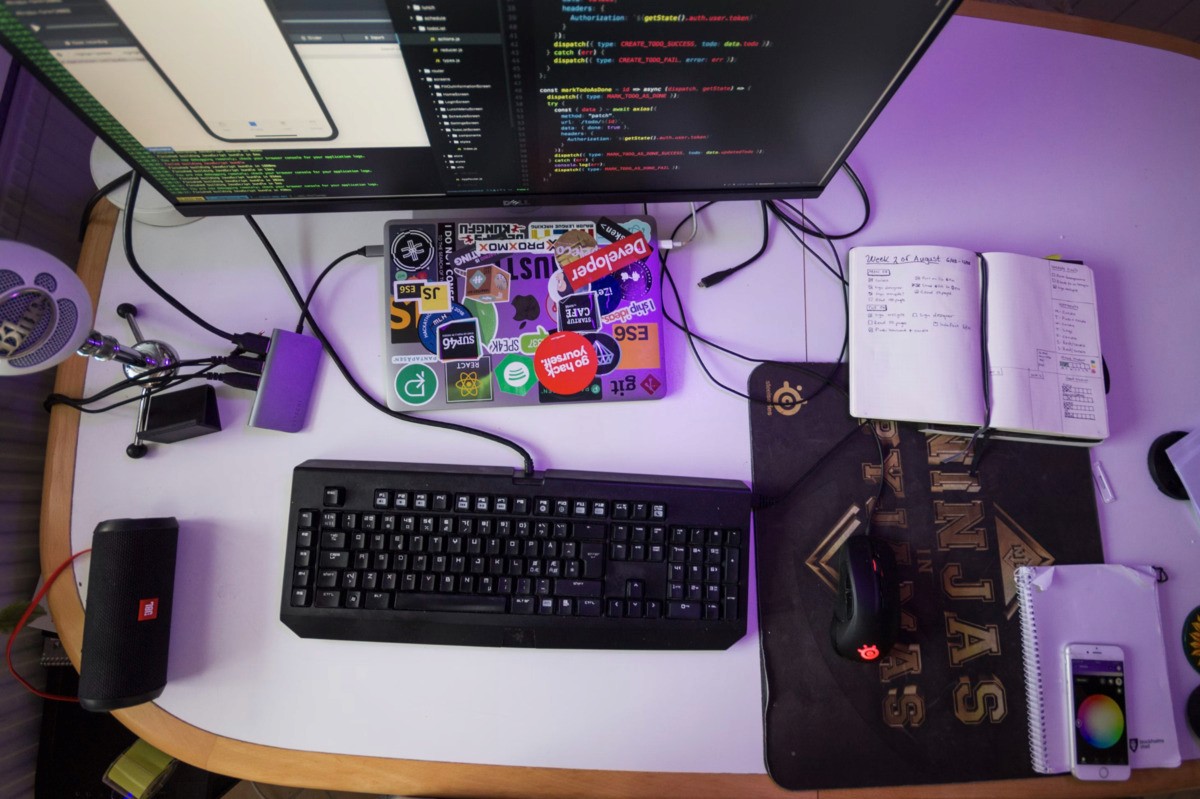Instant Connection for Pixel Streaming
— New Feature Automated Setup





Best Ways to Launch and Market Your Indie Game
Best Ways to Launch and Market Your Indie Game
Best Ways to Launch and Market Your Indie Game
Published on September 24, 2023
Table of Contents
Indie game development is an exciting and eccentric world of creativity and innovation where small teams or individual developers craft unique gaming experiences outside the limitations of big-brand publishers. This independent spirit created some of the most beloved and influential cult classic titles, like Braid and Super Meat Boy, and modern hits like Minecraft. However, the indie game market is crazy competitive, and creating a winning game is only part of the shebang. To make indie games successful, indie developers must master the art of effective game marketing, promotion, and well-planned launch strategies.

Photo by Oskar Yildiz on Unsplash
The Indie Game Landscape
Before diving into marketing strategies, let’s define what makes an indie game. Individual developers create indie games, small teams, or small independent studios without financial backing from major publishers. This freedom from corporate constraints allows for greater creativity and often results in games that push artistic boundaries and offer fresh gameplay experiences.

Indie games rose to the main stage in the shareware games of the 1990s, and they’ve experienced a comeback in popularity due to better online distribution services since the late 2000s. Funding for indie games can now come from various sources, like crowdfunding, smaller publishers, or building a supportive community around the game, making marketing a game much easier and more effective.
Pre-Launch Points to Consider

Game Development and Polishing
Before deep diving into marketing, ensuring your game is well polished and ready for launch is essential. Players have high expectations, and a buggy or incomplete game can harm your reputation, so invest lots of time in playtesting, Q&A, and refining your game.
Market Research
Understand your target audience and your game’s competition. This will help you create more effective marketing strategies. Identify gaps in the market and how your game can fill them.
Crafting a Brand Identity
Establish a unique brand identity for your game. This includes creating a compelling narrative and defining your game’s unique selling points (USPs). What makes your game stand out in an oversaturated market?
Creating a Comprehensive Marketing Plan

Know Your Audience
Identify your target audience and their specific niches. Your marketing message should resonate with them. Understanding your audience helps in crafting great marketing campaigns.
Positioning and Messaging
Clearly define how your game is positioned in the market. Develop a concise and compelling message that communicates what makes your game unique. Use this messaging consistently across all marketing channels to create a memorable familiarity.
Budget Allocation
Determine your marketing budget and allocate it wisely. Prioritize marketing efforts based on what will have the most significant impact. Don’t overspend on one aspect and neglect others.
Leveraging Social Media Platforms
Building an Audience
Platforms like Twitter, Facebook, Instagram, and TikTok are excellent for building an audience and generating buzz. Consistency is key, so maintain an active presence and engage with your followers constantly.
Engaging Content
Create interesting content that showcases your game’s features and updates. Contests and giveaways can generate excitement. Use relevant hashtags wisely to increase visibility and reach a wider audience.
A Professional Website
Invest in a professional website for your game. It should provide information about the game, gameplay trailers, and a way to capture leads, such as email sign-ups.
Community Engagement
Gaming Communities and Forums
Participate in gaming communities, forums, and subreddits related to your game’s genre. Engage with the community, share your progress, and seek feedback. Building a genuine connection with potential players is invaluable.
Email Marketing
Don’t underestimate the power of good old email. Build a large mailing list of like-minded gamers and keep them updated on the game’s development, release dates, subscriptions, and updates. Personalized emails like these will ultimately build a loyal fanbase. Content is king!
Influencer Marketing
Collaborate with popular influencers, such as YouTubers and streamers, who cater to your target audience. Offer them early access to your game for reviews, gameplay showcases, guides, walkthroughs, tips, and tricks, and leverage their influence to reach a wider audience.
Cross-Promotion
Explore partnerships with other small game developers or game-related networks for cross-promotion. This can help you tap into new user bases and expand your game’s reach further.
Events and Awards
Engage in online events, competitions, and awards. These opportunities can bring recognition and credibility to your indie game.
Success Stories
Learning from success stories like Angry Birds, Monkey Labour, Dustforce, and Fall Guys can provide valuable insights into effective indie game marketing strategies. These games used a combination of early marketing, influencer partnerships, and community building to succeed despite initial budget constraints.
Minecraft
Minecraft started as an indie sensation but quickly grew into one of the most iconic games in the industry. The sandbox game launched in 2011 and first caught players’ attention with its limitless creative potential. It allows players to build, explore, and survive in a blocky, step-by-step-generated world.
In 2014, Microsoft bought developer Mojang Studios for a staggering $2.5 billion, solidifying Minecraft’s place in gaming history. With a thriving modding community, it remains a hugely popular title, now holding the title of the best-selling video game of all time, with over 200 million copies sold worldwide across multiple platforms.
Undertale
Undertale, created by developer Toby Fox, emerged as an indie RPG masterpiece in late 2015. Its uniqueness lies in player choices significantly affecting the game’s narrative and relationships with the quirky inhabitants of the Underground. From its compelling characters to its mesmerizing soundtrack, Undertale earned rapid acclaim and a devoted fan base.
Players can embark on different journeys, from peaceful pacifist runs to challenging genocide runs, giving each playthrough a distinct experience. Undertale’s immense success is a testament to the power of indie creativity.
Rocket League
Rocket League, a blend of soccer and cars, defied expectations to become a beloved indie sensation. Psyonix is the developer, and this game’s pick-up-and-play nature quickly attracted players looking for fast-paced, competitive fun. Going free-to-play in 2020 further increased Rocket League’s popularity, leading to consistently high viewership on platforms like Twitch. Its accessibility and thrilling gameplay ensure that Rocket League continues to score big in the indie gaming arena.
Hollow Knight
Hollow Knight, a Unity game by Australian developer Team Cherry, blends the atmospheric storytelling of Dark Souls with the exploration of a Metroidvania platformer. Players guide a nameless knight through the hauntingly beautiful, interconnected tunnels of Hallownest.
This indie gem’s gripping world and challenging boss battles showcase meticulous game design and beautiful hand-drawn animation. Its success is a testament to the enduring appeal of indie games that masterfully combine compelling storytelling lore with engaging gameplay.
Celeste
Celeste, developed by Maddy Thorson and a small team, is more than just a challenging platformer; it’s a profound narrative experience. This indie title employs trial-and-error platforming, storytelling, memorable characters, and an expertly crafted soundtrack to keep players scaling its heights. In just one year, it got Game of the Year nominations and won Best Independent Game at the Game Awards, selling over a million copies across platforms. Celeste is a shining example of indie games’ potential to deliver challenging gameplay and emotional depth.
Stardew Valley
Stardew Valley, created by developer Eric “ConcernedApe” Barone, brought the joys of farming life to players in 2016. Inheriting a run-down farm from your grandfather, you can choose to cultivate the land or build relationships with the charming farming townsfolk. The game’s simple yet engaging narrative and character development resonate with players, leading to sales exceeding ten million copies across various platforms. Stardew Valley showcases how indie developers can create deeply immersive, relaxing experiences that captivate players for countless hours.
Terraria
Terraria, developed by Re-Logic, remains an enduring indie cult classic. This sandbox game offers an impressive array of mechanics, from combat and boss battles to world-building and nifty crafting. Its randomly generated worlds encourage exploration, and the game’s regular updates have kept it fresh for over a decade. Terraria is a testament to the lasting appeal of indie games that empower players to shape their own adventures in a dynamic, ever-changing gaming world.
Shovel Knight
Shovel Knight is a classic indie success story. With development by a group of former WayForward employees at Yacht Club Games, this 8-bit platformer stars a knight with a shovel as his weapon of choice. Crowdfunded on Kickstarter, Shovel Knight debuted to overwhelming and instant acclaim in 2014. The game’s retro graphics, compelling narrative, and memorable characters have made it an inspiration for indie game developers worldwide. Shovel Knight has even made over two dozen cameos in other games, solidifying its status as an indie icon.
The Binding Of Isaac
The Binding of Isaac, created by Edmund McMillen and Florian Himsl, began as a relatively low-key release on Steam in 2011. However, it exploded onto the main stage through word of mouth and YouTube videos, gathering a dedicated fan base. The game’s mix of roguelike elements and twisted themes resonated with players, leading to multiple console ports, expansions, and even a hugely acclaimed sequel, The Binding of Isaac: Rebirth. This dark and addictive indie title shows how unique concepts can find unexpected success in the indie gaming world.
Cuphead
Cuphead, by StudioMDHR, pays a beautiful and lasting homage to 1930s cartoons. This quirky, run-and-gun game features stunning, hand-drawn animations and challenging boss battles. Since its release in 2017, Cuphead has sold over six million game copies.
The game’s success led to the release of the DLC “The Delicious Last Course” in 2022 and even an animated Netflix series. Cuphead demonstrates how indie developers can create visually captivating and engaging experiences that speak to players of all ages.
Conclusion
Creating an epic game is just the beginning in the ever-changing and challenging indie game development world. Effective marketing and promotion are essential for your game to rise above a competitive market. Start early, engage with your audience, use social media, and build a strong, loyal community of diehard fans.
By following these strategies and learning from successful indie game marketing case studies, you can increase your chances of launching a game that captures the hearts of players and gains cult attraction. Remember, in the world of indie gaming, innovation and creative marketing go hand in hand.
Indie game development is an exciting and eccentric world of creativity and innovation where small teams or individual developers craft unique gaming experiences outside the limitations of big-brand publishers. This independent spirit created some of the most beloved and influential cult classic titles, like Braid and Super Meat Boy, and modern hits like Minecraft. However, the indie game market is crazy competitive, and creating a winning game is only part of the shebang. To make indie games successful, indie developers must master the art of effective game marketing, promotion, and well-planned launch strategies.

Photo by Oskar Yildiz on Unsplash
The Indie Game Landscape
Before diving into marketing strategies, let’s define what makes an indie game. Individual developers create indie games, small teams, or small independent studios without financial backing from major publishers. This freedom from corporate constraints allows for greater creativity and often results in games that push artistic boundaries and offer fresh gameplay experiences.

Indie games rose to the main stage in the shareware games of the 1990s, and they’ve experienced a comeback in popularity due to better online distribution services since the late 2000s. Funding for indie games can now come from various sources, like crowdfunding, smaller publishers, or building a supportive community around the game, making marketing a game much easier and more effective.
Pre-Launch Points to Consider

Game Development and Polishing
Before deep diving into marketing, ensuring your game is well polished and ready for launch is essential. Players have high expectations, and a buggy or incomplete game can harm your reputation, so invest lots of time in playtesting, Q&A, and refining your game.
Market Research
Understand your target audience and your game’s competition. This will help you create more effective marketing strategies. Identify gaps in the market and how your game can fill them.
Crafting a Brand Identity
Establish a unique brand identity for your game. This includes creating a compelling narrative and defining your game’s unique selling points (USPs). What makes your game stand out in an oversaturated market?
Creating a Comprehensive Marketing Plan

Know Your Audience
Identify your target audience and their specific niches. Your marketing message should resonate with them. Understanding your audience helps in crafting great marketing campaigns.
Positioning and Messaging
Clearly define how your game is positioned in the market. Develop a concise and compelling message that communicates what makes your game unique. Use this messaging consistently across all marketing channels to create a memorable familiarity.
Budget Allocation
Determine your marketing budget and allocate it wisely. Prioritize marketing efforts based on what will have the most significant impact. Don’t overspend on one aspect and neglect others.
Leveraging Social Media Platforms
Building an Audience
Platforms like Twitter, Facebook, Instagram, and TikTok are excellent for building an audience and generating buzz. Consistency is key, so maintain an active presence and engage with your followers constantly.
Engaging Content
Create interesting content that showcases your game’s features and updates. Contests and giveaways can generate excitement. Use relevant hashtags wisely to increase visibility and reach a wider audience.
A Professional Website
Invest in a professional website for your game. It should provide information about the game, gameplay trailers, and a way to capture leads, such as email sign-ups.
Community Engagement
Gaming Communities and Forums
Participate in gaming communities, forums, and subreddits related to your game’s genre. Engage with the community, share your progress, and seek feedback. Building a genuine connection with potential players is invaluable.
Email Marketing
Don’t underestimate the power of good old email. Build a large mailing list of like-minded gamers and keep them updated on the game’s development, release dates, subscriptions, and updates. Personalized emails like these will ultimately build a loyal fanbase. Content is king!
Influencer Marketing
Collaborate with popular influencers, such as YouTubers and streamers, who cater to your target audience. Offer them early access to your game for reviews, gameplay showcases, guides, walkthroughs, tips, and tricks, and leverage their influence to reach a wider audience.
Cross-Promotion
Explore partnerships with other small game developers or game-related networks for cross-promotion. This can help you tap into new user bases and expand your game’s reach further.
Events and Awards
Engage in online events, competitions, and awards. These opportunities can bring recognition and credibility to your indie game.
Success Stories
Learning from success stories like Angry Birds, Monkey Labour, Dustforce, and Fall Guys can provide valuable insights into effective indie game marketing strategies. These games used a combination of early marketing, influencer partnerships, and community building to succeed despite initial budget constraints.
Minecraft
Minecraft started as an indie sensation but quickly grew into one of the most iconic games in the industry. The sandbox game launched in 2011 and first caught players’ attention with its limitless creative potential. It allows players to build, explore, and survive in a blocky, step-by-step-generated world.
In 2014, Microsoft bought developer Mojang Studios for a staggering $2.5 billion, solidifying Minecraft’s place in gaming history. With a thriving modding community, it remains a hugely popular title, now holding the title of the best-selling video game of all time, with over 200 million copies sold worldwide across multiple platforms.
Undertale
Undertale, created by developer Toby Fox, emerged as an indie RPG masterpiece in late 2015. Its uniqueness lies in player choices significantly affecting the game’s narrative and relationships with the quirky inhabitants of the Underground. From its compelling characters to its mesmerizing soundtrack, Undertale earned rapid acclaim and a devoted fan base.
Players can embark on different journeys, from peaceful pacifist runs to challenging genocide runs, giving each playthrough a distinct experience. Undertale’s immense success is a testament to the power of indie creativity.
Rocket League
Rocket League, a blend of soccer and cars, defied expectations to become a beloved indie sensation. Psyonix is the developer, and this game’s pick-up-and-play nature quickly attracted players looking for fast-paced, competitive fun. Going free-to-play in 2020 further increased Rocket League’s popularity, leading to consistently high viewership on platforms like Twitch. Its accessibility and thrilling gameplay ensure that Rocket League continues to score big in the indie gaming arena.
Hollow Knight
Hollow Knight, a Unity game by Australian developer Team Cherry, blends the atmospheric storytelling of Dark Souls with the exploration of a Metroidvania platformer. Players guide a nameless knight through the hauntingly beautiful, interconnected tunnels of Hallownest.
This indie gem’s gripping world and challenging boss battles showcase meticulous game design and beautiful hand-drawn animation. Its success is a testament to the enduring appeal of indie games that masterfully combine compelling storytelling lore with engaging gameplay.
Celeste
Celeste, developed by Maddy Thorson and a small team, is more than just a challenging platformer; it’s a profound narrative experience. This indie title employs trial-and-error platforming, storytelling, memorable characters, and an expertly crafted soundtrack to keep players scaling its heights. In just one year, it got Game of the Year nominations and won Best Independent Game at the Game Awards, selling over a million copies across platforms. Celeste is a shining example of indie games’ potential to deliver challenging gameplay and emotional depth.
Stardew Valley
Stardew Valley, created by developer Eric “ConcernedApe” Barone, brought the joys of farming life to players in 2016. Inheriting a run-down farm from your grandfather, you can choose to cultivate the land or build relationships with the charming farming townsfolk. The game’s simple yet engaging narrative and character development resonate with players, leading to sales exceeding ten million copies across various platforms. Stardew Valley showcases how indie developers can create deeply immersive, relaxing experiences that captivate players for countless hours.
Terraria
Terraria, developed by Re-Logic, remains an enduring indie cult classic. This sandbox game offers an impressive array of mechanics, from combat and boss battles to world-building and nifty crafting. Its randomly generated worlds encourage exploration, and the game’s regular updates have kept it fresh for over a decade. Terraria is a testament to the lasting appeal of indie games that empower players to shape their own adventures in a dynamic, ever-changing gaming world.
Shovel Knight
Shovel Knight is a classic indie success story. With development by a group of former WayForward employees at Yacht Club Games, this 8-bit platformer stars a knight with a shovel as his weapon of choice. Crowdfunded on Kickstarter, Shovel Knight debuted to overwhelming and instant acclaim in 2014. The game’s retro graphics, compelling narrative, and memorable characters have made it an inspiration for indie game developers worldwide. Shovel Knight has even made over two dozen cameos in other games, solidifying its status as an indie icon.
The Binding Of Isaac
The Binding of Isaac, created by Edmund McMillen and Florian Himsl, began as a relatively low-key release on Steam in 2011. However, it exploded onto the main stage through word of mouth and YouTube videos, gathering a dedicated fan base. The game’s mix of roguelike elements and twisted themes resonated with players, leading to multiple console ports, expansions, and even a hugely acclaimed sequel, The Binding of Isaac: Rebirth. This dark and addictive indie title shows how unique concepts can find unexpected success in the indie gaming world.
Cuphead
Cuphead, by StudioMDHR, pays a beautiful and lasting homage to 1930s cartoons. This quirky, run-and-gun game features stunning, hand-drawn animations and challenging boss battles. Since its release in 2017, Cuphead has sold over six million game copies.
The game’s success led to the release of the DLC “The Delicious Last Course” in 2022 and even an animated Netflix series. Cuphead demonstrates how indie developers can create visually captivating and engaging experiences that speak to players of all ages.
Conclusion
Creating an epic game is just the beginning in the ever-changing and challenging indie game development world. Effective marketing and promotion are essential for your game to rise above a competitive market. Start early, engage with your audience, use social media, and build a strong, loyal community of diehard fans.
By following these strategies and learning from successful indie game marketing case studies, you can increase your chances of launching a game that captures the hearts of players and gains cult attraction. Remember, in the world of indie gaming, innovation and creative marketing go hand in hand.
Get Beyond Your Computer Performance
Run applications on your cloud computer with the latest generation hardware. No more crashes or lags.

Trial includes 1 hour usage + 7 days of storage.
Get Beyond Your Computer Performance
Run applications on your cloud computer with the latest generation hardware. No more crashes or lags.

Trial includes 1 hour usage + 7 days of storage.
Get Beyond Your Computer Performance
Run applications on your cloud computer with the latest generation hardware. No more crashes or lags.

Trial includes 1 hour usage + 7 days of storage.
Get Beyond Your Computer Performance
Run applications on your cloud computer with the latest generation hardware. No more crashes or lags.

Trial includes 1 hour usage + 7 days of storage.
Get Beyond Your Computer Performance
Run applications on your cloud computer with the latest generation hardware. No more crashes or lags.

Trial includes 1 hour usage + 7 days of storage.

Ready to focus on your creativity?
Vagon gives you the ability to create & render projects, collaborate, and stream applications with the power of the best hardware.

Vagon Blog
Run heavy applications on any device with
your personal computer on the cloud.
San Francisco, California
Solutions
Vagon Teams
Vagon Streams
Use Cases
Resources
Vagon Blog
The Best Render Settings for Blender 3D
Arcware vs Vagon Streams: Best Pixel Streaming Alternatives
How To Use FL Studio on a Cloud Computer
Reducing Latency in Virtual Desktops: 11 Fixes That Actually Work
PureWeb vs Vagon Streams: Best Alternative Pixel Streaming Platform
How To Use Photoshop On iPad
How To Fix Slow & Laggy Performance on AWS Workspaces VDIs?
Arcane Mirage vs Vagon Streams: Best Alternative Pixel Streaming Platform
The Best Unity Shortcuts
Vagon Blog
Run heavy applications on any device with
your personal computer on the cloud.
San Francisco, California
Solutions
Vagon Teams
Vagon Streams
Use Cases
Resources
Vagon Blog
The Best Render Settings for Blender 3D
Arcware vs Vagon Streams: Best Pixel Streaming Alternatives
How To Use FL Studio on a Cloud Computer
Reducing Latency in Virtual Desktops: 11 Fixes That Actually Work
PureWeb vs Vagon Streams: Best Alternative Pixel Streaming Platform
How To Use Photoshop On iPad
How To Fix Slow & Laggy Performance on AWS Workspaces VDIs?
Arcane Mirage vs Vagon Streams: Best Alternative Pixel Streaming Platform
The Best Unity Shortcuts
Vagon Blog
Run heavy applications on any device with
your personal computer on the cloud.
San Francisco, California
Solutions
Vagon Teams
Vagon Streams
Use Cases
Resources
Vagon Blog
The Best Render Settings for Blender 3D
Arcware vs Vagon Streams: Best Pixel Streaming Alternatives
How To Use FL Studio on a Cloud Computer
Reducing Latency in Virtual Desktops: 11 Fixes That Actually Work
PureWeb vs Vagon Streams: Best Alternative Pixel Streaming Platform
How To Use Photoshop On iPad
How To Fix Slow & Laggy Performance on AWS Workspaces VDIs?
Arcane Mirage vs Vagon Streams: Best Alternative Pixel Streaming Platform
The Best Unity Shortcuts
Vagon Blog
Run heavy applications on any device with
your personal computer on the cloud.
San Francisco, California
Solutions
Vagon Teams
Vagon Streams
Use Cases
Resources
Vagon Blog



